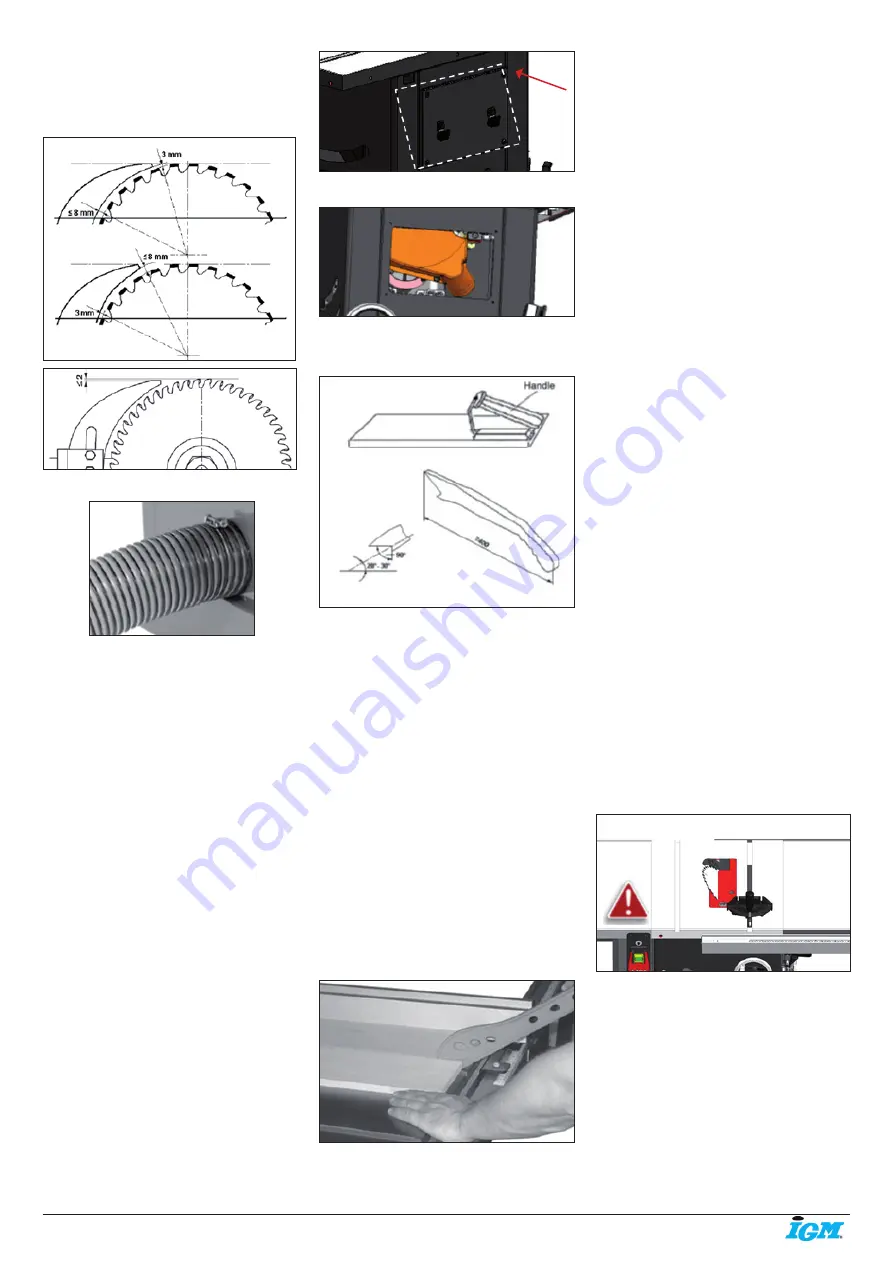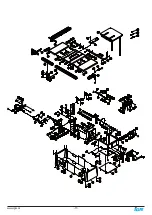
-14-
www.igm.cz
at least 2mm beneath the topmost tooth.
The riving knife must be at least 0.2 mm thicker
than the main saw blade.
Check that the saw blade clamping system is
tight before operating the machine!
Dust Collector:
There is a 100 mm dust outlet located on
the lower left of the saw cabinet allowing for
the connection to a dust collection system
(not included). Air current speed is 20m/s for
vacuum suction dust emission index. When
air current speed of dust collector device (in
accordance with EN 12779:2004+ A1:2009) is
not lower than 20m/s, ensure machine can be
normal exhausted. User must wear dustproof
mask.
1. Fit the 100 mm dust hose over the dust port,
(not included) and secure in place with a hose
clamp.
2. Make sure the hose could not come off.
3. Required air flow: 934 m3/h
4. Ensure pressure drop of each dust collector
outlet carrying air current speed: 1500Pa
5. Wind speed of dust collector tube m/s: dry
chips: 20m/s, water content is equal to18% wet
chips: 28m/s.
Warning: Always turn on the dust collector
before starting the saw and stop the saw before
turning off the dust collector.
Note.: A tight fit is necessary for proper
performance.
Warning: Always turn off the table saw before
removing any cover of the machine.
Remove the side cover, to clean and remove
dust, debris from dust hood.
7.5 Push block and push stick
A push block (Pic.2) and A push stick (Pic.3)
must be used.
If the workpiece is less then 12 0mm, you must
use the push stick to prevent your hands from
getting too close to the saw blade.
Push block must be used to cut narrow
workpieces and, when necessary, to push the
workpiece against the fence, a push block can
be easily made by the operator as Pic.
Warning: Use only the push stick provided by
the manufacturer or constructed in accordance
with the instructions. This push stick provides
sufficient distance of the hand from the saw
blade.
Warning: Never use a damaged or cut push
stick. A damaged push stick may break causing
your hand to slip into the saw blade.
8. Type of Cut
Warning: Always wear safety glasses, a
respirator and hearing protection when
operating this machine.
Note: This saw is only designed to cut wood.
8.1 Ripping
Cutting a wood plank or sheet of plywood
lengthwise to reduce its width is called “ripping”.
To rip stock, hold the work with both hands
pushing it into the blade as well as firmly
against the rip fence so that it is cut straight.
• Never rip or cut wood without using the fence
or mitre gauge to guide it because the stock
could kickback.
• Always use the blade guard and riving knife
assembly when cutting wood. The riving knife
prevents the saw “kerf” (the slit cut by the
blade) from closing and binding the blade,
which can overload and/or stall the motor or
cause the blade to lift and eject the workpiece
towards the front of the saw at very high
speeds. The blade guard keeps your fingers
away from the blade and also reduces the
amount of sawdust flying free.
• Some jobs may require removing the riving
knife along with the cover. Do not forget to put
them back when you are done.
As you complete the rip, the wood will either
remain on the table, tilt up to be caught on
the end of the guard, or fall onto the floor (or
outfeed table). The waste part of the stock
remains on the table to be removed only after
the saw is stopped (unless it is large enough for
immediate safe removal).
If the work to be ripped is narrow, it is safer
to use a push stick, rather than the hands, to
feed it into the blade Push sticks with non-slip
grippers can be purchased, but a shop-made
one works just as well. When ripping extremely
narrow stock that may not clear the width of
the blade guard, or very thin material such
as panelling, which may slip between the
underside of the fence and the table surface,
a strip of wood as an auxiliary guide can be
attached to the fence.
WARNING: Keep the blade guard installed and
in the down position. Failure to do this could
result in serious personal injury or death.
WARNING: Never reach in towards the blade
while the blade is still spinning! whenever a rip
cut is completed, turn off the saw and wait for
the blade to come to a complete stop before
reaching in to remove the workpiece or the
waste material.
8.2 Bevel Ripping
Bevel ripping is performed the same as ripping
but with the saw blade set to an angle not
perpendicular with the table surface. To tilt the
blade to the left, anywhere between 0° and 45°.
This is used most often when cutting bevels,
compound mitres or chamfers.
After changing the bevel angle verify the
alignment of the guard and splitter; make sure
there is clearance with the saw blade.




































